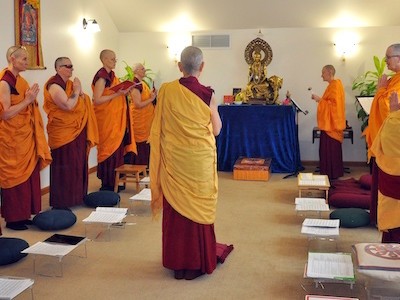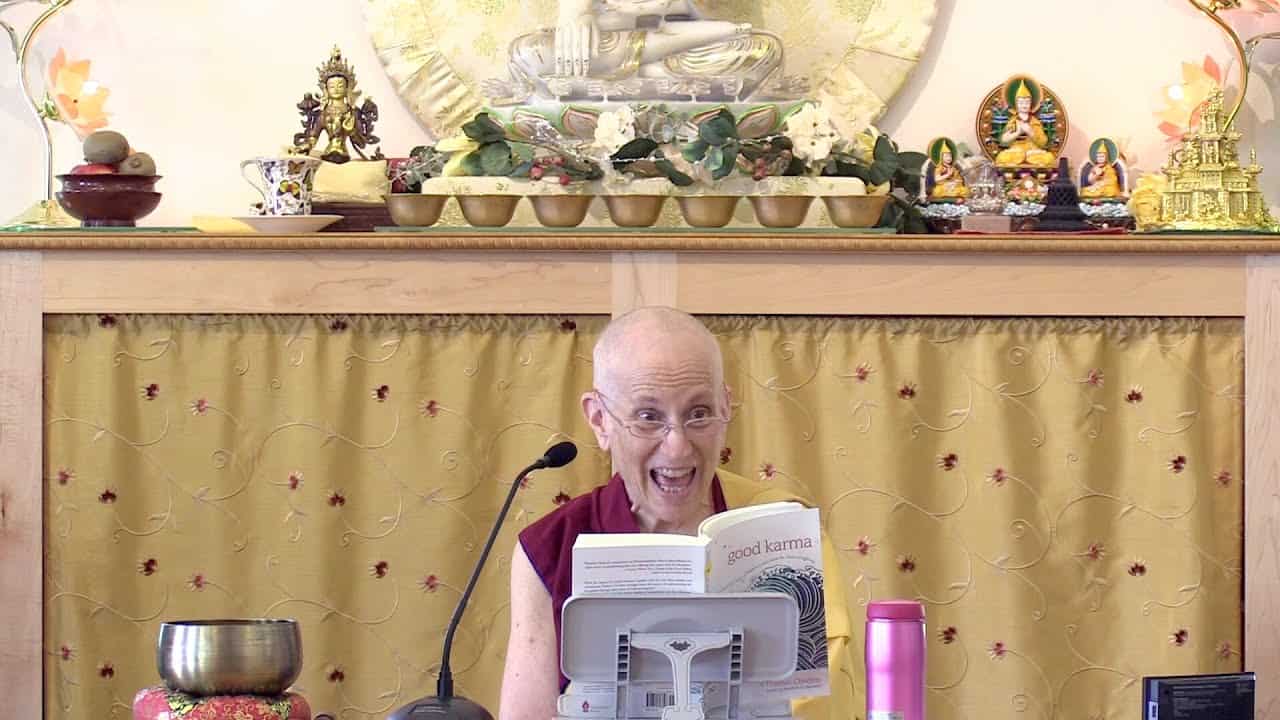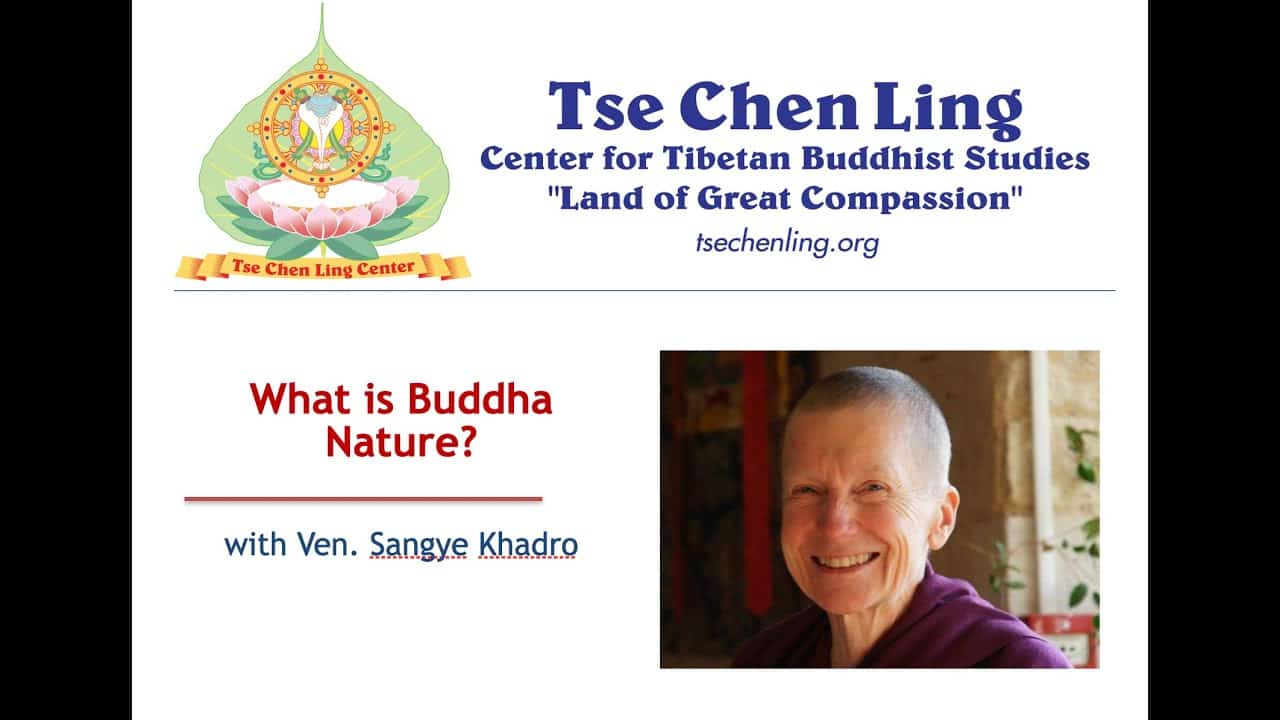Posadha at Sravasti Abbey

Homage to the Omniscient One!
The Buddha set aside two days every month—the new and full moon—for the Posadha (Uposatha in Pali, Sojong in Tibetan), a rite during which monastics are to purify and restore their precepts. This is a day for internal reflection as well as for community gathering. The actual rite in monasteries consists of the reading or recitation of the Pratimoksha precepts by a gathering of at least four fully ordained nuns (bhiksunis) or four fully ordained monks (bhiksus). The actual Posadha is preceded by confessing any transgressions of precepts we may have committed. Each Vinaya tradition and within that, each monastery, may add other practices to the reviewing of the precepts.
We’d like to share with you how we perform Posadha at Sravasti Abbey, one of the few monasteries established for non-Tibetans who follow Tibetan Buddhism in the West. We follow the Dharmaguptaka Vinaya and do all Vinaya rites and ceremonies in English. We’re happy to share our translations of the Chinese texts with you.
On Posadha days, all monastics and lay people take the eight Mahayana precepts in the early morning and keep them strictly for one day. We usually perform the Posadha at 7:00pm, but also at other times if it conflicts with other events.
The Posadha ceremony is preceded by confession on a few different levels.
- Lay guests meet together at the time of the Posadha to perform the refuge and precept ceremony, a rite to confess transgressions and renew their refuge and lay precepts. Based on the teachings of Lama Thubten Yeshe and compiled by Bhiksuni Thubten Chodron, this rite is a good way for lay practitioners to reflect on their actions and to purify and restore their precepts. They do this in another room and are led by an anagarika (eight-precept trainee) who is familiar with the ceremony.
- Prior to the Posadha, a few senior bhiksunis gather to confess to each other before meeting with other bhiksunis, junior monastics, and trainees. Each person’s confession consists of an honest admission of transgressions as well as a formal verse of personal confession. At this time, they may share with the others any difficulties in their practice or in community life.
- After the senior bhiksunis’ confession, they meet with the anagarikas (eight-precept trainees) who confess any transgressions of the eight vows they hold and to review the state of their mind from the previous two weeks, noting any strong afflictions or personal difficulties, and how they’re working with them.
- In another room, shiksamanas meet with senior bhikshunis to confess any of their transgressions.
- After the senior bhiksunis have taken the confessions of each other, of the novices and anagarikas, and of any bhiksunis in the territory (sima) who are ill or doing work for the sangha, they will join the rest of the bhiksunis. All bhikshunis stand in a circle and confess any precept transgressions and discuss any strong afflictions or personal problems, and how they’re working with them. This is also a time when monastics can bring up any Vinaya-related issues.
- Then, in groups of three, the bhiksunis request the senior bhikshunis to be the amends-attester for their confession, followed by reciting the formal verse of confession to “affirm that they can perform the Posadha with purity.”
- We then follow the text of the Posadha ceremony for Dharmaguptaka bhiksunis which includes the saṅghakarman to do the Posadha ceremony, the chanting of confession verses, the introduction to the Bhiksuni Pratimoksa, another saṅghakarman to recite the bhiksuni precepts, concluding stanzas, and dedication.
Anagarikas perform the refuge and precept ceremony and do not attend the Posadha. Shiksamanas are invited to participate in the confession and repentance and to listen to the introduction of the Pratimoksha recitation. However, they are not present during the saṅghakarmans. They are then requested to recite their precepts in another room while the bhiksunis read/recite the bhiksuni precepts and concluding rites.
At Sravasti Abbey, we encourage people to be open and transparent and to avoid concealing transgressions and other actions that they regret having done. This creates an atmosphere of openness where people feel comfortable with one another. They know that everyone in the community is doing their best and that everyone makes mistakes. We are encouraged to support one another when someone has difficulties or is going through a hard time. We stop trying to project an image to one another of being “perfect monastics” or “learned Dharma practitioners.” This relieves a lot of tension and allows us to be human with each other. It also creates a feeling of belonging to a community where everyone has the same aims and is going in the same direction.
This kind of open self-reflection and sharing promotes honesty, transparency, and trust within the monastic community, as well as supporting our integrity in observing ethical conduct and precepts. These are essential elements for creating harmony in the sangha and sustaining the Dharma in the world.
The Buddha’s appearance in the world is to be widely celebrated.
Listening to the Dharma and practicing it accordingly is the surest cause for peace.
The harmony of the assembly is the surest factor for nirvāṇa.
Liberating sentient beings from suffering is the utmost happiness.
Venerable Thubten Chodron
Venerable Chodron emphasizes the practical application of Buddha’s teachings in our daily lives and is especially skilled at explaining them in ways easily understood and practiced by Westerners. She is well known for her warm, humorous, and lucid teachings. She was ordained as a Buddhist nun in 1977 by Kyabje Ling Rinpoche in Dharamsala, India, and in 1986 she received bhikshuni (full) ordination in Taiwan. Read her full bio.


